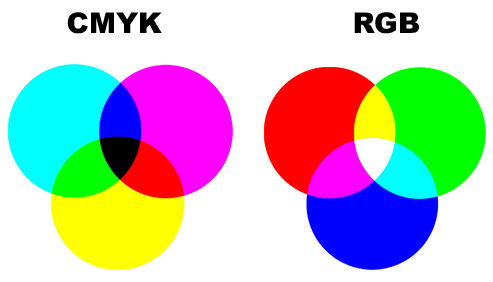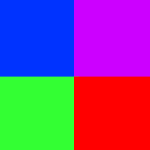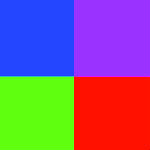From CMYK / HEX to RGB
This useful tool converts to and from color code systems CMYK (Cyan, Magenta, Yellow, Key) and RGB (Red, Green, Blue). Additionally, it shows the HEX color code so you can see if the color is the matter. You can also enter a HEX code and see which CMYK and RGB code are closest to.
This conversion tool thus converts from the following color code systems:
- From CMYK to RGB & HEX
- From RGB to CMYK & HEX
- From HEX to RGB & CMYK
How to use it?
To use the tool, enter the codes in one of the CMYK, RGB or HEX color systems. You can press the "Tab key" to move the cursor to the next field. Once you have entered color codes, press the must key outside the fields, the codes will automatically appear in addition to the nearest HEX color code.
CMYK and RGB
The CMYK color model is used in printing processes. To understand it, it's best to start with RGB colors. The RGB color model (consisting of red, green, and blue ( R ed, G reen, B hat) is used on your computer screen, and that's what you want to see the pictures while still on the screen. However, these colors can only be seen naturally or produced light, such as in the computer screen, and not on a printed page. This is where CMYK comes in.
(The text continues under the picture)

CMYK in graphic design
Graphic designers must relate to the question of seeing their work on the screen in RGB, even though their final result being printed will be in CMYK. Digital files must be converted to CMYK before they are sent to printers, unless otherwise specified. Due to this problem, it is important to use "color samples" when designing if exact color matching is important. Color samples give a designer and its client an example of how a color will look like on the paper. The selected color sample can then be selected in Photoshop (or similar application) to ensure the desired result. Although color on the screen does not match the color scheme, you now know how the final color will look. You may also want to print a sample from the printer as an example of printing before you run the entire job.
The difference between RGB and CMYK
Many people have questions regarding web colors they see on the screen compared to what they see in brochures and other print media. RGB and CMYK are the two most prominent and typical color areas / formats / models used in the world of design. In print, web or digital media, a basic understanding of what the differences can mean means that a designer can significantly improve the quality of a project. RGB (Red, Green, Blue) is the typical color system used by electronic monitors, monitors, PDA displays, etc. In RGB, images are made by combining red, green and blue lights. A mixture of these colors can create millions of different colors using varying concentrations of primary colors. So when designing a website, web banner, buttons, e-newsletter, or the like, your photos and files should be added to this profile. The chance that WEB image is set to RGB that stands is very big, but it is always a good practice to check. CMYK is the primary color model used by color printers. So for flyers, brochures, advertisements, newsletters, direct mail pieces, etc., a CMYK profile can provide better quality or a better expectation of what the results will be. CMYK creates different colors in a subtractive process using four colors or ink: cyan (blue), magenta (red), yellow (yellow) and black (black). It is highly probable that your inkjet or laser printer at home has a CMYK or CMYK similar setup. There are many RGB colors that CMYK printers can not reproduce. Something that looks good on the screen may not hold the quality of the paper. CMYK is the primary color model used by color printers. So for flyers, brochures, advertisements, newsletters, direct mail pieces, etc., a CMYK profile can provide better quality or a better expectation of what the results will be. CMYK creates different colors in a subtractive process using four colors or ink: cyan (blue), magenta (red), yellow (yellow) and black (black). It is highly probable that your inkjet or laser printer at home has a CMYK or CMYK similar setup. There are many RGB colors that CMYK printers can not reproduce. Something that looks good on the screen may not hold the quality of the paper. CMYK is the primary color model used by color printers. So for flyers, brochures, advertisements, newsletters, direct mail pieces, etc., a CMYK profile can provide better quality or a better expectation of what the results will be. CMYK creates different colors in a subtractive process using four colors or ink: cyan (blue), magenta (red), yellow (yellow) and black (black). It is highly probable that your inkjet or laser printer at home has a CMYK or CMYK similar setup. There are many RGB colors that CMYK printers can not reproduce. Something that looks good on the screen may not hold the quality of the paper. CMYK creates different colors in a subtractive process using four colors or ink: cyan (blue), magenta (red), yellow (yellow) and black (black). It is highly probable that your inkjet or laser printer at home has a CMYK or CMYK similar setup. There are many RGB colors that CMYK printers can not reproduce. Something that looks good on the screen may not hold the quality of the paper. CMYK creates different colors in a subtractive process using four colors or ink: cyan (blue), magenta (red), yellow (yellow) and black (black). It is highly probable that your inkjet or laser printer at home has a CMYK or CMYK similar setup. There are many RGB colors that CMYK printers can not reproduce. Something that looks good on the screen may not hold the quality of the paper.
RGB Colors
(What you see on screen) |
CMYK Color Model
(Printed with ink) |
Why colors look different
RGB System - Screen Only!
The RGB color system is only suitable for on-screen display such as LCD and CRT computer monitors and TV monitors. This system is not suitable for printing or comparing colors from, as each screen may display colors differently. Something that may look nice on your screen can look completely different to another. This may be due to a variety of reasons, either due to individual display settings such as brightness and contrast, due to the fact that the screen is manufactured by two different screen manufacturers, ie Sony or LG.
The red, green, and blue components are the amounts of red, green and blue light that an RGB contains and is measured in values from 0 to 255. To view these values, open a drawing program on your computer and dig in the color settings.
The RGB color model is an additive color model. Additive color models use transmitted light to display colors. Displays using the RGB color model. When you add red, blue, and green light so that the value of each component is 255, white (color) appears. When the value of each component is 0, the result is pure black.
CMYK / Process - Digital printing
CMYK, also known as process colors, is usually used in digital printing for signage. CMYK refers to the four colors used; C yan, M agent, Y ellow and Blac K to generate a color. It's these four colors that blend together to make the other colors, quite similar to the principle of how paint colors are mixed.
One thing to note is that CMYK colors can not look identical to physical colors due to limitations on the number of colors CMYK can exchange and the reason that ink behaves differently. For example, orange is very hard to reproduce, and can look very muddy when printed digitally.
CMYK color model defines color using the following components:
C Cyan (this is a blue ink color)
M Magenta (this is a pink ink color)
Y Yellow
(black ink) K Black (black ink, the sign 'K' is used to it should not be confused with B in RGB. RGB was invented first)
Cyan, Magenta, Yellow and Black components are the amounts of blp, pink, yellow and black ink that CMYK contains and is measured in percent 0-100. The CMYK color model is a subtractive color model. Subtractive color models use reflective light to show color. Printed material is produced using the CMYK color model. When combining Cyan, Magenta, Yellow and Black, so that the value of each component is 100, the result is black. When the value of each component is 0, the result is pure white.